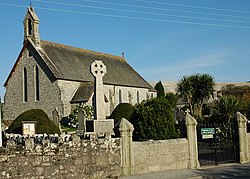Nanpean
| Nanpean | |
| Cornwall | |
|---|---|
 Nanpean parish church | |
| Location | |
| Location: | 50°22’5"N, 4°52’8"W |
| Data | |
| Local Government | |
| Council: | Cornwall |
Nanpean (Cornish: Little Valley) is a village in the midst of Cornwall, standing beside the B3279 road approximately four miles northwest of St Austell in the heart of 'clay country', the china clay quarrying area of mid-Cornwall. It is close by St Stephen-in-Brannel and within its civil parish.
Nanpean church was built in 1879 dedicated to St George the Martyr. The building has an apsidal chancel, nave and south aisle, and a small bell turret. Nanpean also had a Wesleyan Methodist chapel. [1]
The village has a school, Nanpean Community Primary School[2] The original village school was built in 1898. It was refurbished and extended in 2002 and a further extension was added in 2004.

The Newquay and Cornwall Junction Railway (a branch from the Cornish Main Line at Burngullow) opened as far as Nanpean in 1869 and was extended in 1874 to connect with the Par to Newquay branch at St Dennis Junction.[3] The railway carried goods traffic only so there was never a station at Nanpean; the southern section remains open (2010) for china clay freight trains.
There are plans to build 150 -300 homes as part of the St Austell and Clay Country Eco-town. The plan was given outline approval in July 2009.[4]
Economic history
Nanpean is at the heart of the china clay mining area of mid-Cornwall, known locally as the "clay country". It was one of the most important centres in the clay country for administration, management, processing, research, transport and supply, and the village reflects that complexity of economic function. It was a centre supplying the social, religious, educational and commercial needs of an area remote from older settlement centres.[5]
In the 1930s, Nanpean had a range of businesses, including a cobbler's shop, which in addition to its economic function, served as a debating forum for local men to discuss important issues of the day, however there is a much smaller range of businesses based in Nanpean today.[6]
Outside links
| ("Wikimedia Commons" has material about Nanpean) |
References
- ↑ Information on Nanpean from GENUKI
- ↑ Nanpean School
- ↑ R Barton; History of the Cornish China-clay Industry; published by Bradford Barton; 1966; ISBN 0-85153-038-9
- ↑ "Drinnick and Nanpean". ECO-BOS. http://eco-bos.com/our-plans/masterplan-sites/drinnick-nanpean/. Retrieved 7 November 2010.
- ↑ "Nanpean (Hensbarrow area)". Cornwall Industrial Settlements Initiative. Cornwall Historic Environment Service. http://www.historic-cornwall.org.uk/cisi/nanpean/CISI_Nanpean_report.pdf. Retrieved 2011-06-18.
- ↑ Trethewey, M. (2011). "Memories of Nanpean". Old Cornwall XIV (4): 69–73. http://shop.oldcornwall.org/journal.htm. Retrieved 2011-06-18.